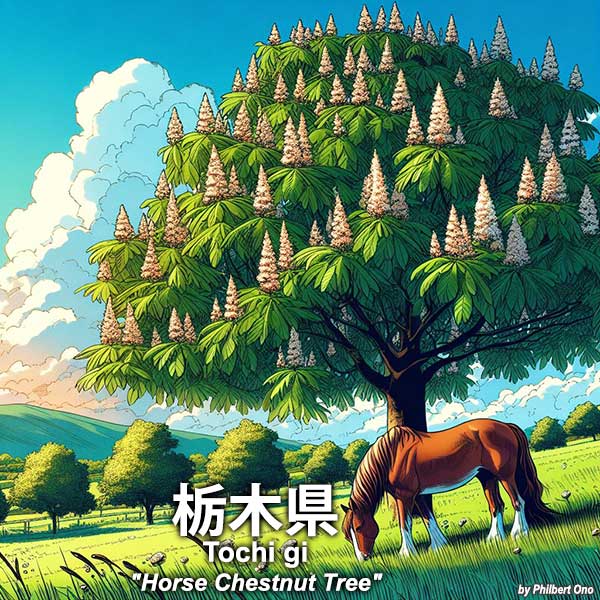TOCHIGI – Horse Chestnut Tree 栃木県

No one knows for sure how the name Tochigi originated. The name “Tochigi” appeared as early as 1394 when Tochigi Castle was built by Minagawa Hidemitsu (皆川秀光) in what is now central Tochigi city.
Although the kanji characters for Tochigi seem to refer to the horse chestnut tree, the name is probably not related to this tree. Why the tochi (栃) kanji character came to be used in the name is unknown. Not only that, variants of the tochi kanji (杤, 橡) were also used until the present kanji 栃 was officially sanctioned in Oct. 1872.
Multiple theories for using Tochi:
Theory 1: It came from 十千木 (To-chigi) with To meaning “ten” and chigi is Shinmyogu Shrine’s (神明宮) chigi roof prong ornaments. The shrine is in Tochigi city where the prefectural capital was first located.
Theory 2: There were a lot of horse chestnut trees (tochi 栃).
Theory 3: Frequent flooding of Uzuma River (巴波川) caused land erosion (chigi-ru 千切る) in Tochigi. And only To was appended as a prefix. This makes the Tochigi kanji characters ateji, used only for phonetic purposes.
Theory 4: A god named Toyoki-Iribiko-no-Mikoto (豊城入彦命) named the province “Totsuki” (遠つ木国 or 遠津木) to differentiate it from two similar province names referring to Kinokuni (木国) in Gunma and Tochigi and to Kinokuni (紀伊国) in Wakayama and Mie. The Totsuki name later morphed into “Tochigi.”
Tochigi Castle was dismantled during the early 17th century and Tochigi became a lodging town for travelers on the road to Nikko. (Tochigi Castle site is now a public park.) The prefecture was named after Tochigi town where the prefectural capital was located. It has since moved to Utsunomiya, but the prefectural name stuck.
Although it is unknown how the horse chestnut tree is historically related to Tochigi Prefecture, the prefecture’s official tree is indeed the Japanese horse chestnut tree or Tochi-no-ki (栃の木 Aesculus turbinata) native to Japan.
In Utsunomiya, Japanese horse chestnut trees line Symbol Road in front of the prefectural capital building. Its large leaves look like a human hand. The stacks of flowers shaped like ice cream cones bloom in May-June. After the flowers wilt, horse chestnuts appear. They are edible.
Created in 2009, the prefecture’s official mascot named “Tochimaru-kun” is designed after the Japanese horse chestnut.
Old province name: Shimotsuke-no-Kuni (下野国)
Source: https://www.pref.tochigi.lg.jp/c05/kensei/aramashi/kenmin.html
*The AI-generated image is for illustrative purposes only and may not accurately depict any particular place in the prefecture.
*Major reference sources: Official prefectural website, Japanese Wikipedia, other websites.
Origin of other prefectural names (etymologies)
Overview | Aichi | Akita | Aomori | Chiba | Ehime | Fukui | Fukuoka | Fukushima | Gifu | Gunma | Hiroshima | Hokkaido | Hyogo | Ibaraki | Ishikawa | Iwate | Kagawa | Kagoshima | Kanagawa | Kochi | Kumamoto | Kyoto | Mie | Miyagi | Miyazaki | Nagano | Nagasaki | Nara | Niigata | Oita | Okayama | Okinawa | Osaka | Saga | Saitama | Shiga | Shimane | Shizuoka | Tochigi | Tokushima | Tokyo | Tottori | Toyama | Wakayama | Yamagata | Yamaguchi | Yamanashi